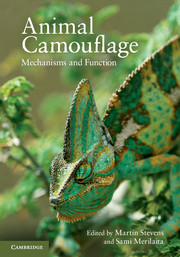Book contents
- Frontmatter
- Contents
- Contributors
- 1 Animal camouflage
- 2 Crypsis through background matching
- 3 The concealment of body parts through coincident disruptive coloration
- 4 The history, theory and evidence for a cryptic function of countershading
- 5 Camouflage-breaking mathematical operators and countershading
- 6 Nature's artistry
- 7 Camouflage behaviour and body orientation on backgrounds containing directional patterns
- 8 Camouflage and visual perception
- 9 Rapid adaptive camouflage in cephalopods
- 10 What can camouflage tell us about non-human visual perception? A case study of multiple cue use in cuttlefish (Sepia spp.)
- 11 Camouflage in marine fish
- 12 Camouflage in decorator crabs
- 13 Camouflage in colour-changing animals
- 14 The multiple disguises of spiders
- 15 Effects of animal camouflage on the evolution of live backgrounds
- 16 The functions of black-and-white coloration in mammals
- 17 Evidence for camouflage involving senses other than vision
- Index
- Plate section
- References
16 - The functions of black-and-white coloration in mammals
Review and synthesis
Published online by Cambridge University Press: 05 June 2012
- Frontmatter
- Contents
- Contributors
- 1 Animal camouflage
- 2 Crypsis through background matching
- 3 The concealment of body parts through coincident disruptive coloration
- 4 The history, theory and evidence for a cryptic function of countershading
- 5 Camouflage-breaking mathematical operators and countershading
- 6 Nature's artistry
- 7 Camouflage behaviour and body orientation on backgrounds containing directional patterns
- 8 Camouflage and visual perception
- 9 Rapid adaptive camouflage in cephalopods
- 10 What can camouflage tell us about non-human visual perception? A case study of multiple cue use in cuttlefish (Sepia spp.)
- 11 Camouflage in marine fish
- 12 Camouflage in decorator crabs
- 13 Camouflage in colour-changing animals
- 14 The multiple disguises of spiders
- 15 Effects of animal camouflage on the evolution of live backgrounds
- 16 The functions of black-and-white coloration in mammals
- 17 Evidence for camouflage involving senses other than vision
- Index
- Plate section
- References
Summary
Patches of black-and-white fur or skin are the subject of this chapter but they seem an unlikely form of camouflage. Conspicuous pelage conjures up aposematism or intraspecific communication (Wallace 1889) but we cannot take this for granted because three forms of camouflage may involve conspicuous coloration. These are disruptive coloration that relies on contrasting colours (Cott 1940; Cuthill & Szekely 2009; Stevens & Merilaita 2009), high-contrast markings that may draw the attention of the viewer, impeding detection or recognition of prey (Dimitrova et al. 2009), and background matching in environments that have dark shadows, or white snow and ice (Thayer 1909). Furthermore, aposematic colour patterns can be conspicuous nearby but cryptic at a distance (Marshall 2000; Tullberg et al. 2005; Gomez & Thery 2007). Unfortunately, there have been very few attempts to document or test theories about black-and-white coloration in mammals.
Here I categorise all terrestrial mammals into ten different groupings, and marine mammals into three, based principally on the placement and pattern of black-and-white patches of fur or skin. Then I use natural history and principles of animal coloration to suggest why certain species have evolved conspicuous coloration. Many of the great Victorian and twentieth-century naturalists debated issues of animal coloration in just such a way (Caro et al. 2008a, b). The novelty of my review is that it is comprehensive (although not completely exhaustive) but it faces some problems. First, I may have misclassified species because conspicuous coloration apparent in photographs or descriptions may not be conspicuous under natural conditions (see Wallace 1889; Poulton 1890; Thayer 1909; Hingston 1933).
- Type
- Chapter
- Information
- Animal CamouflageMechanisms and Function, pp. 298 - 329Publisher: Cambridge University PressPrint publication year: 2011
References
- 11
- Cited by



